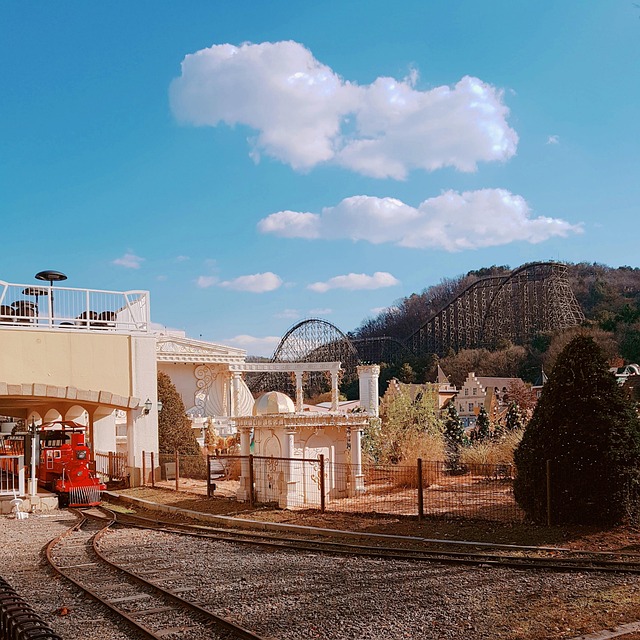In the late 19th century, Lane County, Oregon, experienced significant transformation with the advent and expansion of railroads. This period saw the construction of railway lines that snaked through diverse landscapes, revolutionizing transportation and spurring economic growth. The railroad expansion connected remote areas, stimulating trade, and leading to the development of numerous bustling railroad towns. This history left an indelible mark on Lane County's communities, fostering cultural mix and economic diversification. Today, historic rail lines and stations preserve Oregon's rich transportation heritage, with modern industries offering scenic rides and museum attractions, seamlessly blending past and present.
“Unraveling the Historical Journey of Lane County’s Railroads: From Early Beginnings to Modern Legacy
Lane County, Oregon, boasts a rich railway heritage that has shaped its landscape and communities. This article explores the fascinating story of railroad expansion in the region, beginning with the pioneers’ quest for connectivity. We delve into the impact of Oregon’s railroad boom on local towns, the network’s development, and the eventual rise and fall of this vital industry. Discover how Lane County’s railroad history continues to influence its modern identity.”
- Early Railroad Beginnings in Lane County: A Pioneer Journey
- Oregon Railroad Expansion: The Impact on Lane County Communities
- Building the Rail Network: Connecting Lane County Towns
- The Rise and Fall of Railroads in Lane County
- Legacy and Modernity: Lane County's Railroad Heritage Today
Early Railroad Beginnings in Lane County: A Pioneer Journey

In the late 19th century, Lane County in Oregon experienced a pivotal moment with the arrival and expansion of railroads, marking a new era of connectivity and economic growth. The journey began with the construction of the first railway lines that snaked their way through the lush landscapes and rugged terrains of the county. These early railroads played a crucial role in transforming the region by facilitating the transportation of goods, people, and ideas. Towns along these routes flourished, becoming bustling hubs of activity with the influx of new businesses and residents.
The Oregon railroad expansion brought about significant changes in Lane County’s rail industry, fostering the development of numerous railroad towns that became integral parts of the local fabric. The railway network connected remote areas, opening up new opportunities for trade and commerce. As trains navigated through scenic valleys and over majestic peaks, they carried with them the hopes and aspirations of pioneers seeking to shape a new future. This pioneer journey on rails left an indelible mark on Lane County’s history, shaping its landscape and communities as we know them today.
Oregon Railroad Expansion: The Impact on Lane County Communities

The expansion of railroads in Lane County, Oregon, during the 19th century brought about a transformative impact on local communities. As the iron horses chugged their way across the scenic landscapes, they connected remote areas and fostered economic growth. The arrival of railroads sparked the development of railroad towns along the route, each with its unique character and history. These towns became bustling hubs, attracting businesses and residents, and leading to a diversification of the local economy.
The Lane County rail industry played a pivotal role in shaping the region’s culture and demographics. Railroad workers, from engineers to conductors and laborers, brought diverse backgrounds and skills, contributing to a vibrant mix of people. The expansion also facilitated the transportation of goods, enabling farmers and ranchers to access wider markets for their produce. This increased trade and commerce left an indelible mark on Lane County’s history, solidifying its place as a significant transportation corridor in Oregon.
Building the Rail Network: Connecting Lane County Towns

The expansion of the railroad network in Lane County, Oregon, played a pivotal role in shaping the region’s history and economy. As part of a broader Oregon railroad expansion effort, the construction of rail lines connected various towns within Lane County, fostering growth and facilitating trade. These railroads became lifelines for the local communities, enabling the transportation of goods and people across vast distances.
The development of Lane County railroads brought significant changes to the region. It spurred the growth of small towns along the routes, many of which became bustling centers of commerce and industry. The rail industry attracted businesses and workers, leading to increased population and diverse economic opportunities. This period marked a transformative phase in Lane County’s history, leaving an indelible mark on its landscape and social fabric.
The Rise and Fall of Railroads in Lane County

Legacy and Modernity: Lane County's Railroad Heritage Today

Lane County’s railroad heritage is a testament to its rich history and enduring impact on the region’s development. The expansion of railroads in the late 19th and early 20th centuries transformed Lane County, connecting it to broader economic opportunities and fostering the growth of vibrant railroad towns. Today, remnants of this legacy remain, with historic rail lines still visible and old train stations standing as reminders of Oregon’s railroad expansion.
Modernity has not erased the county’s railroad past; instead, it has preserved and reinterpreted it. The Lane County rail industry continues to thrive, although in different forms. Tourists now enjoy scenic train rides that traverse the lush landscapes, echoing the bustling days of yesteryear. Railroad museums and historic sites attract visitors interested in exploring Oregon’s transportation history. This blend of legacy and modernity showcases how Lane County has embraced its past while forging ahead, ensuring that its railroad heritage remains an integral part of its identity.
